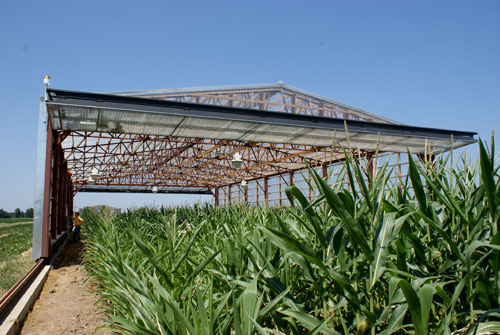*Drought simulator will enable in-depth testing under real-world conditions*
COLUMBIA, Mo. – Historically, droughts have had devastating effects on agriculture, causing famine and increasing consumer food costs. Now, researchers at the University of Missouri College of Agriculture, Food and Natural Resources (CAFNR) have completed two drought simulators designed to test the effects of water deficiency on crops. The simulators are located at the University of Missouri’s Bradford Research and Extension Center east of Columbia.
The simulators, part of a $1.5 million Missouri Life Sciences Research Board grant, are essentially mobile greenhouses measuring 50 feet by 100 feet. To simulate drought, researchers move the greenhouses over plants when it is raining and move them away from plants when it is sunny. A test plot of the same plants will be kept next to the simulator to provide a comparison. The drought simulators will increase the real-world application of scientific research, as they allow researchers to more closely mimic actual drought conditions.

MU plant sciences researchers Bob Sharp (left) and Felix Fritschi have just completed a drought simulator that will allow them to simulate drought conditions in the field. Thirteen co-investigators from several disciplines including water quality, soil biology, soil physics, plant-insect and plant-disease interaction, and plant breeding, genetics and plant root biology will collaborate on the project. Image credit: University of Missouri
When funding is available, additional simulators will be built at the Delta Research Center in Portageville, Mo., in the southeastern part of the state, and at the Horticulture and Agroforestry Research Center in New Franklin, Mo. These locations represent a variety of environments, crop species and soil types, allowing researchers to test any agriculturally important crop, forage and turf species grown in Missouri and surrounding states.

Using the drought simulator, MU researchers will be able to study how plants respond to different soil conditions and how their root systems grow. Image credit: University of Missouri
“This network of drought simulators will be unlike any other network in the U.S., providing Missouri scientists with state-of-the-art field facilities to conduct a broad range of drought-related research,” said Felix Fritschi, assistant professor in the CAFNR Division of Plant Sciences. “Our objective is to develop real-world products and practices to improve food security and increase profitability for farmers.”

The drought simulator is mounted on a set of tracks, allowing it to cover the plants when it is raining or slide back during sunny weather. Image credit: University of Missouri
“The ability to manage the timing, duration and intensity of water-deficit stress under field conditions is essential to examine plant responses to drought,” said Bob Sharp, a co-investigator and director of MU’s Interdisciplinary Plant Group. “Thus, the drought simulators will bridge the gap between controlled-environment facilities, such as growth chambers and greenhouses, and real conditions encountered in the field.”
Thirteen co-investigators from several disciplines, including water quality, soil biology, soil physics, plant-insect and plant-disease interaction, and plant breeding, genetics and plant root biology will collaborate on the project. Another focus area is tissue dehydration tolerance. Researchers plan to study the genetic characteristics of plants that are extremely tolerant to dry climates and how these characteristics might be used to improve commercial crops.
*Source: University of Missouri
